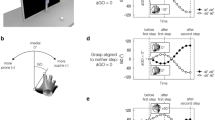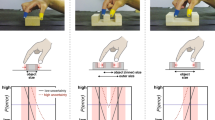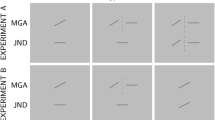Abstract
Choosing appropriate grasp points is necessary for successfully interacting with objects in our environment. We brought two possible determinants of grasp point selection into conflict: the attempt to grasp an object near its center of mass to minimize torque and ensure stability and the attempt to minimize movement distance. We let our participants grasp two elongated objects of different mass and surface friction that were approached from different distances to both sides of the object. Maximizing stability predicts grasp points close to the object’s center, while minimizing movement costs predicts a bias of the grasp axis toward the side at which the movement started. We found smaller deviations from the center of mass for the smooth and heavy object, presumably because the larger torques and more slippery surface for the heavy object increase the chance of unwanted object rotation. However, our right-handed participants tended to grasp the objects to the right of the center of mass, irrespective of where the movement started. The rightward bias persisted when vision was removed once the hand was half way to the object. It was reduced when the required precision was increased. Starting the movement above the object eliminated the bias. Grasping with the left hand, participants tended to grasp the object to the left of its center. Thus, the selected grasp points seem to reflect a compromise between maximizing stability by grasping near the center of mass and grasping on the side of the acting hand, perhaps to increase visibility of the object.




Similar content being viewed by others
References
Alexander RM (1991) Energy-saving mechanisms in walking and running. J Exp Biol 60:55–69
Alexander RM (1997) A minimum energy cost hypothesis for human arm trajectories. Biol Cybern 76:97–105
Berret B, Chiovetto E, Nori F, Pozzo T (2011) Evidence for composite cost function in arm movement planning: an inverse optimal control approach. PLoS Comput Biol 7(10):e1002183. doi:10.1371/journal.pcbi.1002183
Bingham GP, Muchisky MM (1993) Center of mass perception and internal frames of reference. Percept Psychophys 54(5):617–632
Blake A (1995) A symmetry theory of planar grasp. Int J Rob Res 14:425–444
Cuijpers RH, Smeets JBJ, Brenner E (2004) On the relation between object shape and grasping kinematics. J Neurophysiol 91:2598–2606
Eastough D, Edwards MG (2007) Movement kinematics in prehension are affected by grasping objects of different mass. Exp Brain Res 176:193–198
Elliott D, Hansen S, Mendoza J, Tremlay L (2004) Learning to optimize speed, accuracy, and energy expenditure: a framework for understanding speed-accuracy relations in goal-directed aiming. J Mot Behav 36(3):339–351
Endo S, Wing AM, Bracewell RM (2011) Haptic and visual influences on grasp point selection. J Mot Behav 43(6):427–432
Fikes TG, Klatzky RL, Lederman SJ (1994) Effects of object texture on precontact movement time in human prehension. J Mot Behav 26(4):325–332
Goodale MA, Meenan JP, Bülthoff HH, Nicolle DA, Murphy KJ, Racicotm CI (1994) Separate neural pathways for the visual analysis of object shape in perception and prehension. Curr Biol 4:604–610
Harris CM, Wolpert DM (1998) Signal-dependent noise determines motor planning. Nature 394:780–784
Hesse C, de Grave DD, Franz VH, Brenner E, Smeets JBJ (2008) Planning movements well in advance. Cogn Neuropsychol 27(7–8):985–995
Huang HJ, Kram R, Ahmed AA (2012) Reduction of metabolic cost during motor learning of arm reaching dynamics. J Neurosci 32(6):2182–2190
Kistemaker DA, Wong JD, Gribble PL (2010) The Central nervous system does not minimize energy cost in arm movements. J Neurophysiol 104:2985–2994
Kleinholdermann U, Brenner E, Franz VH, Smeets JBJ (2007) Grasping trapezoidal objects. Exp Brain Res 180:415–420
Kleinholdermann U, Franz VH, Gegenfurtner KR (2013) Human grasp point selection. J Vis 13(8):23, 1–12. doi:10.1167/13.8.23
Lederman SJ, Wing AM (2003) Perceptual judgment, grasp point selection and object symmetry. Exp Brain Res 152:156–165
Milgram P (1987) A spectacle-mounted liquid-crystal tachistoscope. Behav Res Methods Instrum Comput 19(5):449–456
Paulignan Y, Frak VG, Toni I, Jeannerod M (1997) Influence of object position and size on human prehension movements. Exp Brain Res 114:226–234
Roby-Brami A, Bennis N, Mokhtari M, Baraduc P (2000) Hand orientation for grasping depends on the direction of the reaching movement. Brain Res 869:121–129
Rosenbaum DA, Marchak F, Barnes HJ, Vaughan J, Slotta JD, Jorgensen MJ (1990) Constraints for action selection: overhand versus underhand grips. In: Jeannerod M (ed) Attention and performance XIII: motor representation and control. Erlbaum, Hillsdale, pp 321–342
Smeets JBJ, Brenner E (1999) A new view on grasping. Mot Control 3:237–271
Soechting JF, Bueno CA, Herrmann U, Flanders M (1995) Moving effortlessly in three dimensions: does Donders’ law apply to arm movements? J Neurosci 15(9):6271–6280
Taniai Y, Nishii J (2008) Optimality of reaching movements based on energetic cost under the influence of signal-dependent noise. In: Ishikawa M, Doya K, Miyamoto H, Yamakawa T (eds) Neural information processing. Springer, Berlin, pp 1091–1099
Todorov E (2004) Optimality principles in sensorimotor control. Nat Neurosci 7(9):907–915
Vanrenterghem J, Bobbert MF, Casius LJ, De Clercq D (2008) Is energy expenditure taken into account in human sub-maximal jumping?—A simulation study. J Electromyogr Kinesiol 18:108–115
Voudouris D, Brenner E, Schot WD, Smeets JBJ (2010) Does planning a different trajectory influence the choice of grasp points? Exp Brain Res 206:15–24
Voudouris D, Smeets JBJ, Brenner E (2012) Do humans prefer to see their grasping points? J Mot Behav 44(4):295–304
Wing AM, Lederman SJ (2009) Points for precision grip. In: Nowak DA, Hermsdörfer J (eds) Sensorimotor control for grasping: physiology and pathophysiology. Cambridge University Press, Cambridge, pp 193–203
Zelik KE, Kuo AD (2012) Mechanical work as an indirect measure of subjective costs influencing human movement. PLoS One 7(2):331143. doi:10.1371/journal.pone.0031143
Acknowledgments
This work was supported by a postgraduate fellowship to VC Paulun granted by the Justus-Liebig University of Gießen and by the DFG International Research Training Group IRTG 1901 “The Brain in Action—BrainAct”.
Conflict of interest
The authors declare that they have no conflict of interest.
Author information
Authors and Affiliations
Corresponding author
Rights and permissions
About this article
Cite this article
Paulun, V.C., Kleinholdermann, U., Gegenfurtner, K.R. et al. Center or side: biases in selecting grasp points on small bars. Exp Brain Res 232, 2061–2072 (2014). https://doi.org/10.1007/s00221-014-3895-z
Received:
Accepted:
Published:
Issue Date:
DOI: https://doi.org/10.1007/s00221-014-3895-z




